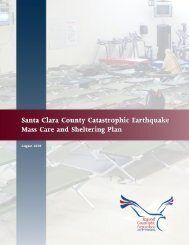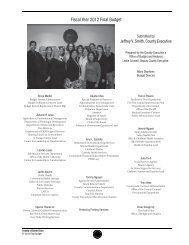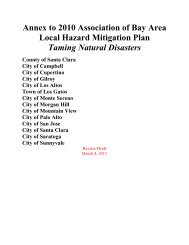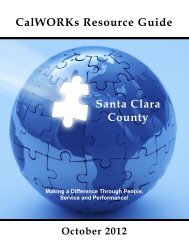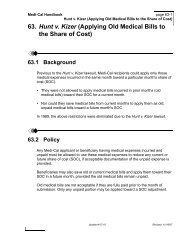Through Their Eyes: Domestic Violence and It's Impact on Children
Through Their Eyes: Domestic Violence and It's Impact on Children
Through Their Eyes: Domestic Violence and It's Impact on Children
Create successful ePaper yourself
Turn your PDF publications into a flip-book with our unique Google optimized e-Paper software.
Chapter 3<br />
“The <strong>Children</strong>’s<br />
<str<strong>on</strong>g>Domestic</str<strong>on</strong>g> <str<strong>on</strong>g>Violence</str<strong>on</strong>g><br />
Program offers<br />
children a time<br />
to discuss <str<strong>on</strong>g>and</str<strong>on</strong>g><br />
think over their<br />
experiences<br />
in a safe <str<strong>on</strong>g>and</str<strong>on</strong>g><br />
n<strong>on</strong>-threatening<br />
manner,” says<br />
Kellie Rogers,<br />
principal advocate<br />
for the program.<br />
“<strong>Children</strong> have<br />
the opportunity to<br />
create their own safety<br />
plans <str<strong>on</strong>g>and</str<strong>on</strong>g> to learn about the<br />
dynamics of domestic violence in a<br />
developmentally appropriate manner.<br />
The staff members of the <strong>Children</strong>’s<br />
<str<strong>on</strong>g>Domestic</str<strong>on</strong>g> <str<strong>on</strong>g>Violence</str<strong>on</strong>g> Program are aware<br />
that children will most likely have<br />
future c<strong>on</strong>tact with the batterer,<br />
especially if he is their father. The<br />
program’s curriculum teaches children<br />
skills so that they will be able to<br />
h<str<strong>on</strong>g>and</str<strong>on</strong>g>le the abuser’s past, present,<br />
<str<strong>on</strong>g>and</str<strong>on</strong>g> future behaviors with the least<br />
amount of damage to themselves.”<br />
One of the tools used by the<br />
<strong>Children</strong>’s <str<strong>on</strong>g>Domestic</str<strong>on</strong>g> <str<strong>on</strong>g>Violence</str<strong>on</strong>g> Program<br />
is drawing. Art is an effective <str<strong>on</strong>g>and</str<strong>on</strong>g><br />
easy way for children who have<br />
experienced violence to c<strong>on</strong>vey<br />
their experiences <str<strong>on</strong>g>and</str<strong>on</strong>g> to define their<br />
own emoti<strong>on</strong>al worlds. The pictures<br />
you see throughout this book were<br />
produced by children in the program.<br />
Many children find it easier to put<br />
their feelings into pictures rather<br />
than to express them out loud.<br />
Drawing pictures allows them freedom<br />
from judgment <str<strong>on</strong>g>and</str<strong>on</strong>g> pressure.<br />
Another strategy that Rogers employs<br />
is empathic listening, or truly listening<br />
to what the children are saying.<br />
Sometimes, in working with children<br />
who have been defined as “difficult”<br />
by their school or day care, she<br />
discovers that she is the first pers<strong>on</strong><br />
to sit down <str<strong>on</strong>g>and</str<strong>on</strong>g> ask the child why<br />
they were engaging in troublesome<br />
behaviors.<br />
Additi<strong>on</strong>ally, children receive<br />
informati<strong>on</strong> about creating their own<br />
safety plan. The safety plan helps<br />
them protect themselves during an<br />
incident.<br />
Rogers relates <strong>on</strong>e story of a child<br />
using a safety plan developed in the<br />
<strong>Children</strong>’s <str<strong>on</strong>g>Domestic</str<strong>on</strong>g> <str<strong>on</strong>g>Violence</str<strong>on</strong>g> Program.<br />
If you know a child<br />
who is experiencing<br />
domestic violence in<br />
her or his home, you<br />
can help that child<br />
create a safety plan<br />
if s/he voluntarily<br />
expresses interest in<br />
leaning about how to<br />
manage fear or anger<br />
<str<strong>on</strong>g>and</str<strong>on</strong>g> how to protect<br />
himself/herself.<br />
Here are some things<br />
you can say:<br />
• If you can’t get<br />
outside safely, then<br />
go to your room or<br />
other safe place in<br />
the house.<br />
16



